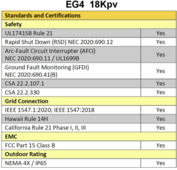I am new to solar and am beginning a mostly DIY installation of a system based on the EG4 18Kpv (no micro-inverters.) I am planning on about 15kW of battery backup. I am a retired electrical engineer, but do not know much about power systems. I am in California and will have to deal with PG&E. Right now, I have no idea what requirements they will have to allow me to hook up my 18Kpv to the grid...or even if I can.
From the link I posted above, Hedges(2nd post) mentions that you can start the registration process on PG&E's website and they basically have a drop down menu of PG&E compliant gear. I have a 100A service panel that is already full. Fortunately, my heat, cooktop, and water heater are all gas, although we did just buy a Tesla. Incoming power lines are underground; I have no idea as to the wire size.
This is one area where I think it might get pricey. When we went to PG&E to do our panel, because we had an overhead feed, no new wiring needed to be run to our house to facilitate our main panel upgrade and even if they did, they wouldn't have to do any excavation work. Your house is on the opposite spectrum, I think. House was built in 1991. I know they will probably have to install a new meter, but how do I tap into that? A meter collar would be ideal but I don't think those are approved by PGE yet.
I'd look into the siemens solar ready panels, See the illustrations on page 2 & 3 of this: https://cache.industry.siemens.com/dl/files/578/109793578/att_1131958/v1/SIE_BR_SolarSolutions.pdf. Also, when you're dealing with PG&E to do the service upgrade or the panel switch, I would make sure the panel you're picking is PG&E compliant beyond just being EUSERC and CA Title 24 compliant. Will they provide grid access or do I need provide some box that they can hook into? Will I need to rip out my old panel and put in a new one?
Hedges posted up a workaround in this thread, so maybe not? I have a friend who's been an electrician working out of the IBEW for nearly 30 years. He's close to you, based out of the San Jose Metro-Area. He might be looking for more side work. If he is, I'm sure he can give you a pretty good rundown of what it would take to get you into a new panel. I'm pretty sure the run down would either be free or very cheap. Let me know if you want me to ask him. I assume I will need a permit for this electrical hookup, but I do not plan on getting a permit for my solar panels
I'm pretty sure you'll need a permit for both, especially if the solar panels are roof mounted, I'd also expect the building dept to want a engineering report showing the roof system is capable of supporting the extra weight. Depending on timing, you might be able to put the electrical hookup of your new panel and solar system on a single permit. This could save you a bit on the permit fees. ...will PGE require that or will they only care about the connection to the 18Kpv? And will I be able to feed back power to the grid?
From my understanding, you'll need to get into a contract with PG&E to backfeed into their grid and i believe they have requirements for what type of solar panels you can use. Too many questions!
I know I am going into this blindly. I am planning on getting some professional help later, but would like to know what I have to look forward to.
This maybe a helpful data point, my 400 AMP panel install cost me about 6k OTD not including permits and there was no cost levied by PG&E.





